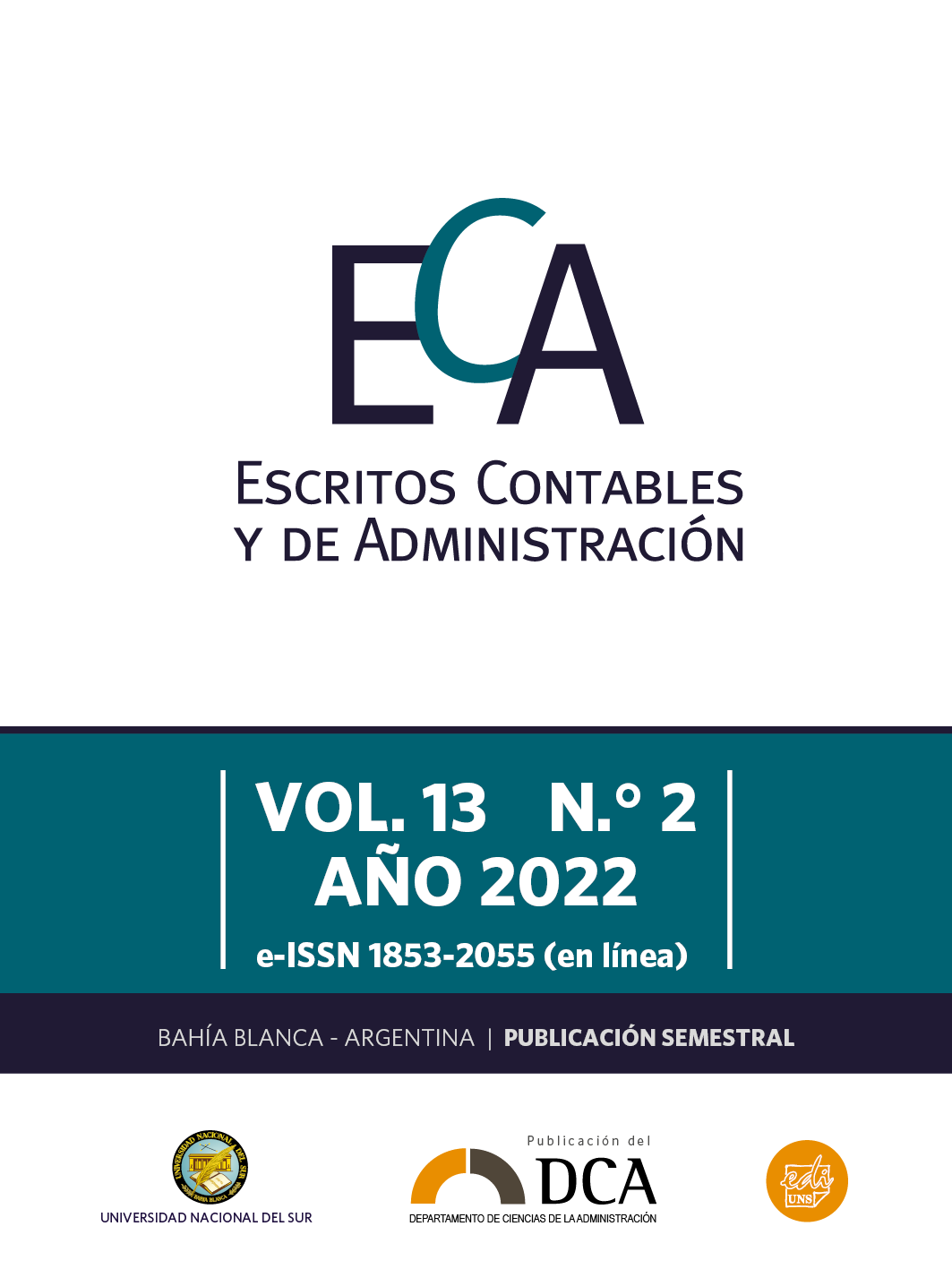Sostenibilidad social y arquitectura: una revisión sistemática de la literatura
DOI:
https://doi.org/10.52292/j.eca.2022.3063Palabras clave:
sostenibilidad social, arquitectura, participación ciudadana, cultura, accesibilidadResumen
La dimensión social de la arquitectura no ha tenido gran desarrollo, a diferencia de la ambiental y económica. Es por ello que este artículo se plantea como objetivos: (1) analizar la evolución de las publicaciones sobre la sostenibilidad social en la arquitectura, a través de una revisión sistemática de la literatura, y (2) resumir los principales aportes de los trabajos más destacados. A partir del análisis bibliométrico, se puede identificar que se trata de una temática de estudio actual: al considerar el total de trabajos existentes sobre la dimensión social de la arquitectura, se encontró que el 75 % han sido publicados en los últimos siete años. Por su parte, al efectuar el análisis de contenido, se detectan tres aristas o temáticas de importancia a la hora de definir la arquitectura sostenible en sus aspectos sociales: la participación ciudadana, la cultura y la accesibilidad. También, se identifican distintos indicadores y herramientas diseñadas desde la administración que pueden contribuir a su medición y monitoreo.
Descargas
Citas
Abdullah, F., Basha, B. y Soomro, A. R. (2017). Sustainable heritage: Analytical study on the viability of adaptive reuse with social approach, case study of Asia heritagerow, Kuala Lumpur. Advanced Science Letters, 23(7), 6179-6183. https://doi.org/10.1166/asl.2017.9231
Al-Jokhadar, A. y Jabi, W. (2017). Applying the vernacular model to high-rise residential development in the Middle East and North Africa. International Journal of Architectural Research (ArchNet-IJAR), 11(2), 175-189. https://www.archnet.org/publications/12017
Alwah, A. A. Q, Li, W., Alwah, M. A. Q. y Shahrah, S. (2021). Developing a quantitative tool to measure the extent to which public spaces meet user needs, Urban Forestry y Urban Greening, 62. https://doi.org/10.1016/j.ufug.2021.127152
Akadiri, P. O., Chinyio, E. A. y Olomolaiye, P. O. (2012). Design of A Sustainable Building: A Conceptual Framework for Implementing Sustainability in the Building Sector, Buildings, 2(2), 126-152. https://doi.org/10.3390/buildings2020126
Andersen, B. y Røe, P. G. (2017). The social context and politics of large scale urban architecture: Investigating the design of Barcode, Oslo. European Urban and Regional Studies, 24(3), 304-317. https://doi.org/10.1177/0969776416643751
Andersson, B. y Gromark, S. (2020). AIDAH-Editors’ post scriptum. En B. Andersson y S. Gromark (eds.), Architecture for Residential Care and Ageing Communities: Spaces for Dwelling and Healthcare (pp. 279-281). Routledge. https://doi.org/10.4324/9780429342370-25
Arenghi, A., Garofolob, I. y Laurìa, A. (2016). On the relationship between ‘universal’ and ‘particular’ in architecture. Studies in Health Technology and Informatics, (229), 31-39. https://www.researchgate.net/publication/307210480_On_the_Relationship_Between_’Universal’_and_’Particular’_in_Architecture
Bacon, N. y Caistor-Arendar, L. (2014). Measuring social sustainability in Sutton. http://www.sociallife.co/media/files/Sutton_Social_Sustainability_Nov14.pdf
Baumanova, M. (2020). Urban kinaesthetic heritage and production of social sustainability. Journal of Archaeological Science: Reports, 32, 102445. https://doi.org/10.1016/j.jasrep.2020.102445
Berkeley-Group y UKGBC (2012). Practical How-to Guide: How to Use a Social Sustainability Framework. London.
Brown, J. e Isaacs, D. (1994). Merging the best of two worlds the core processes of organizations as communities. En P. Senge, A. Kleiner, C. Roberts, R. Ross y B. Smith (eds.), The fifth discipline fieldbook: strategies and tools for building a learning organization (pp. 508-517). Doubleday Currency Publications.
Capolongo, S., Gola, M., Di Noia, M., Nickolova, M., Nachiero, D., Rebecchi, A. y Buffoli, M. (2016). Social sustainability in healthcare facilities: a rating tool for analyzing and improving social aspects in environments of care. Annali dell’Istituto superiore di sanita, 52(1), 15-23. https://pubmed.ncbi.nlm.nih.gov/27033614/
Ceylan, S. y Soygeniş, M. D. (2019). A design studio experience: impacts of social sustainability. Archnet-IJAR: International Journal of Architectural Research, 13(2), 368-385. https://doi.org/10.1108/arch-02-2019-0034
Couret, D. G., Santos, A. H., Calheiros, I. D. y Céspedes, L. V. V. (1998). From a scholar city to a solar city. Renewable energy, 15(1-4), 457-460. https://doi.org/10.1016/s0960-1481(98)00204-3
Department of Sustainability and Environment. (2005). Effective engagement: Building relationships with community and other stakeholders, Book 1: An introduction to engagement, Version 3. Melbourne: Victorian Government Department of Sustainability and Environment.
Durukan, A., Beşir, Ş. E., Altuntaş, S. K. y Açıkel, M. (2021). Evaluation of sustainability principles in adaptable re-functioning: Traditional residences in Demirel Complex. Sustainability, 13(5), 2514, 1-23. https://doi.org/10.3390/su13052514
Elsayed, H. A., AboWardah, E. S. y Ramadan, M. G. (2019). Traditional Market Design towards Cohesion between Social Sustainability and Bioclimatic Approach. IOP Conference Series: Materials Science and Engineering, 471(7), 072002. https://doi.org/10.1088/1757-899x/471/7/072002
Fowles, B. (2012). Transformative architecture: A synthesis of ecological and participatory design. En W. Fox (Ed.), Ethics and the built environment (pp. 118-130). Routledge. https://www.taylorfrancis.com/chapters/edit/10.4324/9780203130513-16/transformative-architecture-synthesis-ecological-participatory-design-bob-fowles
Gibberd, J. (2003). Integrating Sustainable Development into Briefing and Design Processes of Buildings in Developing Countries: An Assessment Tool. [Tesis de doctorado, University of Pretoria (UP)]. http://hdl.handle.net/2263/25525
Hatipoglu, H. K. e Ismail, S. H. (2019). Flexibility: From Tent to Modern Houses in Turkey Evaluation and Guidelines. IOP Conference Series: Materials Science and Engineering, 471(8), 082070. https://doi.org/10.1088/1757- 899x/471/8/082070
Hobbs, J. J. (2017). Heritage in the lived environment of the United Arab Emirates and the Gulf region. ArchNet-IJAR: International Journal of Architectural Research, 11(2), 55. https://www.archnet.org/publications/12009
Ibrahim, I. (2020). Sustainable Courtyards: Practical Experience Potentials. In IOP Conference Series: Earth and Environmental Science, 588(3), 032088. https://doi.org/10.1088/1755-1315/588/3/032088
Janissek Muniz, R., Borges, N. y Bortoli, L. (18-19 de mayo, 2015). Gestão dos sinais fracos no contexto brasileiro: estado da arte. [ponencia]. 8◦ Congresso IFBAE. Gramado, Rio Grande do Sul, Brasil. https://ifbae.s3.euwest3.amazonaws.com/file/congres/2015_B204.pdf
Kearns, A., Whitley, E., Mason, P. y Bond, L. (2012). ‘Living the high life’? Residential, social and psychosocial outcomes for high-rise occupants in a deprived context. Housing Studies, 27(1), 97-126. https://doi.org/10.1080/02673037.2012.632080
Kim, S., & Kwon, H. A. (2018). Urban sustainability through public architecture. Sustainability, 10(4), 1249. https://www.mdpi.com/2071-1050/10/4/1249
Kitchenham, B. (2004). Procedures for performing systematic reviews: Joint Technical Report (Keele University Technical Report TR/SE-0401, NICTA Technical Report 0400011T.1). https://www.inf.ufsc.br/~aldo.vw/kitchenham.pdf
Kohler, N. (1999). The relevance of green building challenge: An observer’s perspective. Building Research & Information, 27(4-5), 309–320. https://doi.org/10.1080/096132199369426
Kóródy, A. y Vukoszávlyev, Z. (2014). Aspects of social sustainability in cases of building rehabilitations in Central Europe. Építés–Építészettudomány, 42(3-4), 287-333. https://doi.org/10.1556/eptud.42.2014.3-4.10
Kostourou, F. (2015). Configurational and morphological sustainability in social housing: The case of Cité Ouvrière. En Proceedings of the 10th International Space Syntax Symposium. Space Syntax Laboratory, The Bartlett School of Architecture. https://www.researchgate.net/publication/282504906_Configurational_and_morphological_sustainability_in_social_housing_The_case_of_Cite_Ouvriere_in_Mulhouse
Kucharczyk-Brus, B. (26-28 de junio, 2013). The implementation of the principles of sustainable development in the residential buildings of big housing estates from the socialist period. [ponencia]. Central Europe towards Sustainable Building Conference. Sustainable Building and Refurbishment for Next Generations. Praga, República Checa. http://www.cesb.cz/cesb13/proceedings/1_refurbishment/CESB13_1210.pdf
Lami, I. M. y Mecca, B. (2021). Assessing Social Sustainability for Achieving Sustainable Architecture. Sustainability (Switzerland), 13(1), 142. https://doi.org/10.3390/su13010142
Lobos, J. (2012). Arquitectura y derechos humanos. Revista AUS, (12), 14-17. https://doi.org/10.4206/aus.2012.n12-04
Lommerse, M. (2014). Working Together: Interior Architecture creating with the community. En Smith, D., Lommerse, M. y Metcalfe, P. (eds.). Perspectives on Social Sustainability and Interior Architecture (pp. 15-40). Springer. https://doi.org/10.1007/978-981-4585-39-2_2
Lommerse, M. [Marina Lommerse]. (s. f.). Inicio [Página de LinkedIn]. LinkedIn. Recuperado el 10 de abril de 2022 de https://www.linkedin.com/in/marina-lommerse-b46ab8a/
Mace, R. (1985). Universal design: Barrier free environments for everyone. Designers West, 33(1), 147-152.
Magnoli, G. C., Talbot, R. D., Atkins, R., Ferrari, G., Shah, K. M. y Chong, T. (2002). Re-building the social capital: Lessons from the city of Edinburgh. Advances in Architecture Series, 14, 663-673. https://www.witpress.com/elibrary/wit-transactions-on-ecology-and-the-environment/54/707
Manterola, C., Astudillo, P., Arias, E., Claros, N. y Mincir, G. (2013). Revisiones sistemáticas de la literatura. Qué se debe saber acerca de ellas. Cirugía española, 91(3), 149-155. https://doi.org/10.1016/j.ciresp.2011.07.009
Mehdinezhad, J. y Nabi, R. N. (2016). Investigating cultural and social sustainability in renovation and durability of vernacular buildings of İran’s architecture (case study: Bazaar of tabriz). IIOAB Journal, 7, 486-495. https://www.iioab.org/articles/IIOABJ_7.S4_486-495.pdf
Metcalfe, P. [Priya Metcalfe]. (s. f.). Inicio [Página de LinkedIn]. LinkedIn. Recuperado el 10 de abril de 2022 de https://www.linkedin.com/in/priya-metcalfe-269b5987/
Mitchel, K. (2010). Learning from Traces of Past Living: Courtyard Housing as Precedent and Project. En N. Rabbat (ed.). The Courtyard House: From Cultural Reference to Universal Relevance (pp. 223-238). Ashgate Publishing Limited, in association with the Aga Khan Program for Islamic Architecture.
Mortada, H. (2003). Traditional Islamic Principles of Built Environment. Routledge. https://doi.org/10.4324/9780203422687
Nuha, A. L. U. y Lukito, Y. N. (2018). Sustaining the Culture of the City: Architecture and Cosmology in the Mantingan Mosque and Cemetery Complex in Jepara. E3S Web of Conferences, 67, 04037. https://doi.org/10.1051/e3sconf/20186704037
Oliver, P. (2003). Dwellings: The Vernacular House World Wide. London: Phaidon Press Limited.
Olukoya, O. A. y Atanda, J. O. (2020). Assessing the Social Sustainability Indicators in Vernacular Architecture Application of a Green Building Assessment Approach. Environments - MDPI, 7(9), 67. https://doi.org/10.3390/environments7090067
Peters, T., y Halleran, A. (2020). How our homes impact our health: using a COVID-19 informed approach to examine urban apartment housing. Archnet-IJAR: International Journal of Architectural Research, 15(1), 10-27. https://doi.org/10.1108/arch-08-2020-0159
Pettinari, S., Perriccioli, M. y Rossi, M. (2011). Life architecture: Open and sustainable building for a strategic dwelling system. En M. Bodart y A. Evrard (Eds.), Architecture and Sustainable Development (vol. 2, pp.501-506). Presses universitaires de Louvain https://books.google.com.ec/booksid=KKZMp2kotAEC&printsec=copyright#v=onepage&q&f=false
Pilechi, P. y Taherkhani, P. (2011). Social sustainability in student dormitories. Procedia Engineering, 21, 59-64. https://doi.org/10.1016/j.proeng.2011.11.1987
Polese, M. y Stren, R. E. (eds.). (2000). The Social Sustainability of Cities. Diversity and the Management of Change. University of Toronto Press. https://doi.org/10.3138/9781442682399-002
Pomeroy, J. (2014). The Skycourt and Skygarden: Greening the Urban Habitat. First Edit. Routledge. https://doi.org/10.4324/9781315881645-8
Raeisi, I., Nezhad, A. K. y Hafezifar, M. (2010). Architectural Design Principles of Public Spaces Based on Social Sustainability Approach: A Case Study in Ardabil, Iran. Design Principles & Practice: An International Journal, 4(5). https://doi.org/10.18848/1833-1874/cgp/v04i05/37968
Ragette, F. (2003). Traditional Domestic Architecture of the Arab Region. Sharjah, UAE: American University of Sharjah.
Sakina, B. [Bunga Sakina]. (s. f.). Inicio [Página de LinkedIn]. LinkedIn. Recuperado el 10 de abril de 2022 de https://www.linkedin.com/in/bunga-sakina-b115a7a2/
Sakina, B. (2018). An assessment of sustainability in architecture based on sustainable building framework – Case study: Mesvara house, Yogyakarta, Indonesia. IOP Conference Series: Earth and Environmental Science, 195, 012093. https://iopscience.iop.org/article/10.1088/1755-1315/195/1/012086
Sakina, B. (2020). A study on crime prevention through environmental design concept application in a private house in Yogyakarta, Indonesia. IOP Conference Series: Earth and Environmental Science, 426(1), 012093. IOP Publishing. https://doi.org/10.1088/1755-1315/426/1/012093
Salameh, M. M., Touqan, B. A., Awad, J. y Salameh, M. M. (2021). Heritage conservation as a bridge to sustainability assessing thermal performance and the preservation of identity through heritage conservation in the Mediterranean city of Nablus. Ain Shams Engineering Journal. 13(2), 101553. https://doi.org/10.1016/j.asej.2021.07.007
Siláči, I. y Vitková, L. (2017). Public Spaces as the Reflection of Society and its Culture, IOP Conference Series: Materials Science and Engineering, 245(4), 042009. https://doi.org/10.1088/1757-899x/245/4/042009
Smith, D. [Dianne Smith]. (s. f.). Inicio [Página de LinkedIn]. LinkedIn. Recuperado el 10 de abril de 2022 de https://www.linkedin.com/in/dianne-smith-a7a4b915/
Smith, D. (2014). Interiors can address social justice: Fact or fiction. En: D. Smith, M. Lommerse y P. Metcalfe, P. (eds.). Perspectives on Social Sustainability and Interior Architecture (pp. 55-78). Springer. https://link.springer.com/chapter/10.1007/978-981-4585-39-2_4
Smith, D., Beeck, S., Lommerse, M. y Metcalfe, P. (2014). An introduction to social sustainability and interior architecture. En: D. Smith, M. Lommerse y P. Metcalfe, P. (eds.). Perspectives on Social Sustainability and Interior Architecture (pp. 1-11). Springer. https://doi.org/10.1007/978-981-4585-39-2_1
Soufiane, F., Said, M., y Atef, A. (2015). Sustainable urban design of historical city centers. Energy procedia, 74, 301-307. https://doi.org/10.1016/j.egypro.2015.07.612
Taylor, B. B. (1985). Contemporary Houses Traditional Values: Tunisia, Egypt, and Morocco. Zamana Gallery.
Vavik, T. (2011). Strategies for teaching universal design. En A. Kovacevic, W. Ion, C. McMahon, L. Buck y P. Hogarth (Eds.), DS 69: Proceedings of E&PDE 2011, the 13th International Conference on Engineering and Product Design Education. Institute of Design at Oslo School of Architecture and Design (AHO) https://www.designsociety.org/publication/30911/Strategies+for+Teaching+Universal+Design
Wan, L. y Ng, E. (2018). Evaluation of the social dimension of sustainability in the built environment in poor rural areas of China. Architectural Science Review, 61(5), 319-326. https://doi.org/10.1080/00038628.2018.1505595 Woodcraft, S. (2012). Social Sustainability and New Communities: Moving from Concept to Practice in the UK. Procedia - Social and Behavioral Sciences 68, 29–42. https://doi.org/10.1016/j.sbspro.2012.12.204
World Health Organization (WHO). (2010). The ICF: an overview. Center for Desease Control and Prevention. https://www.cdc.gov/nchs/data/icd/icfoverview_finalforwho10sept.pdf
Yang, B., Li, S. y Binder, C. (2016) A research frontier in landscape architecture: landscape performance and assessment of social benefits, Landscape Research, 41(3), 314-329. https://doi.org/10.1080/01426397.2015.1077944
Zarghami, E., Fatourehchi, D. y Karamloo, M. (2017). Impact of daylighting design strategies on social sustainability through the built environment. Sustainable Development, 25(6), 504-527. https://doi.org/10.1002/sd.1675
Publicado
Cómo citar
Número
Sección
Licencia
Derechos de autor 2022 Stefani Chavez, Lucía Sarro, Franco Finocchiaro

Esta obra está bajo una licencia internacional Creative Commons Atribución-NoComercial 4.0.
Aviso de derechos de autor
Aquellos autores/as que tengan publicaciones con esta revista, aceptan los términos siguientes:
- Los autores/as conservarán sus derechos de autor y garantizarán a la revista el derecho de primera publicación de su obra, el cual estará simultáneamente sujeto a la licencia Atribución-No Comercial 4.0 Internacional CC BY-NC 4.0.
- Los autores/as podrán adoptar otros acuerdos de licencia no exclusiva de distribución de la versión de la obra publicada (p. ej.: depositarla en un archivo telemático institucional o publicarla en un volumen monográfico) siempre que se indique la publicación inicial en esta revista.
- Se permite y recomienda a los autores/as difundir su obra a través de Internet (por ej.: en páginas web institucionales o personales) una vez publicado su trabajo, lo cual puede producir intercambios interesantes y aumentar las citas de la obra publicada (Véase El efecto del acceso abierto).





















